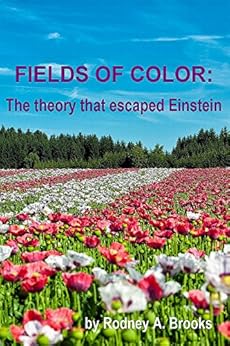 |
| Amazon link |
"Fields of Color explains Quantum Field Theory to a lay audience without equations. It shows how this overlooked and misunderstood theory resolves the weirdness of Quantum Mechanics and the paradoxes of Relativity. The third edition contains a new and simple solution to "the most controversial problem in physics today": the measurement problem." .. from the Amazon page.
Note (updated Friday 27th July 18): having now read this book I don't endorse it. It's simplistic, misleading and dumbed-down to the max. The author, who is an experimentalist, seems to believe that fundamental physics is best understood through a bluff, no-nonsense, concrete interpretation which in no important sense violates our everyday intuitions. Hard to reconcile with the maths (Hilbert space vs spacetime) .. the problematic ontology of operator-valued fields .. and so on. I accept that he believes what he says and that his intentions are good.
---
This post is about quantum gravity. Marginal Revolution provided a link to this article: "a good explanation of why a theory of quantum gravity in particular is needed". The points made are not unfamiliar (see this superior post from Backreaction*) but the issue is at least somewhat clear.
 |
" ...you put a (preferably uncharged) test particle in the middle between the slits to see where the gravitational pull goes. If the gravitational field is quantized, then in half of the cases when the electron goes through the slit, the test particle will move left, in the other half of cases it would move right (it would also destroy the interference pattern). If the gravitational field is classical however, the test particle won’t move because it’s pulled equally to both sides. " (Backreaction). Note that in the former case there's a measurement leading to a 'collapse of the electron wavefunction'. |
Take the seemingly-related question: what is the electric field at a point 'at the screen' of an electron in a state of spatial superposition transiting the two slits? (Of course, we know that the electric field is quantised - the photon is the EM field quantum).
I don't recall this matter ever coming up in the usual QM discussion of the two slit experiment. Those are always concerned solely with the spatial trajectory of the electron itself.
It seems to me that this question can't be addressed within quantum mechanics, which assumes a classical electromagnetic field. Surely one must turn to quantum field theory? (See also this from Physics StackExchange). I don't have any top-level, hand-wavy intuitions about that, though. But the book above by Brooks might help.
Still, in QFT the fields are propagating within a fixed spacetime. When it comes to gravitation we're talking about the dynamic metrical structure of spacetime itself. That theory (quantum gravity) really isn't anchored down at all: the reality underpinning spacetime is utterly unlike the continuum of our naive intuitions.
---
* I had never studied the Schrödinger–Newton equation.
Some more challenging topics here! From the reviews I have read of the Brooks book I do not think that it will help with these kinds of questions. Incidentally is it the same as the AI Rodney Brooks?
ReplyDeleteI think that the Electric field will be a quantum superposition of the alternatives. This question asks us to define the observables for the quantum field and delineate the field as a QM object (perhaps via Fock Space).It is neat that the link between a classical field and the corresponding quantum field is the quantum coherent state (as explored in one of the linked papers.)
As far as the Schrodinger-Newton equation is concerned, the reason that you have not studied it is because in a sense it is a new equation and despite its familiar seeming name it is not a Schrodinger Equation. It is a non-linear modification of the Schrodinger equation that Penrose is currently championing in his non-QM approach to Quantum Gravity. Here QM is modified, but General Relativity remains (almost?) the same and is classical. Penrose has his own experiment design to test this, and it is good to see a different type of experiment in the works.
I am going slightly off the idea that the space-time continuum is unconnected with quantization, but that is for another occasion.
It's a different Brooks. Must lead to a great deal of confusion for them. Thanks for the helpful information about the Schrodinger-Newton equation - I was puzzled by why it was unfamiliar.
ReplyDeleteNote on update:
ReplyDelete(1) Good to see that the other Amazon reviews gave the right message - it was the lack of equations which bothered me.
(2) It is always tricky to catch when you add a blog update, except by reviewing the blog regularly. Format "Note added 27th" or "Note added 2 days later" might help.
(3) I have studied what I have on the Schrodinger-Newton equation in Penrose's "Road to Reality", but that is not as complete (from 2005) as one would like.
(4) Oddly enough a July New Scientist has an article on a third type of experimental test for "Objective Collapse" derivable from the Newton-Schrodinger equation. Some results are in, some negative and one possible positive with more refined tests underway.
(2) Good point: fixed.
Delete(4) Looks like we're at the start of a journey ..